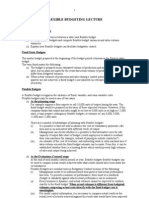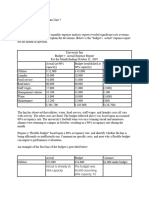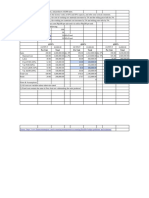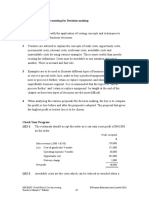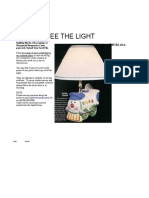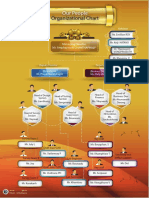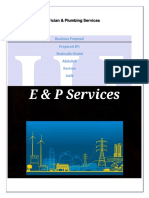Wilkerson Case
Wilkerson Case
Uploaded by
ashibhallauCopyright:
Available Formats
Wilkerson Case
Wilkerson Case
Uploaded by
ashibhallauOriginal Description:
Copyright
Available Formats
Share this document
Did you find this document useful?
Is this content inappropriate?
Copyright:
Available Formats
Wilkerson Case
Wilkerson Case
Uploaded by
ashibhallauCopyright:
Available Formats
University Inn's most recent monthly expense analysis report revealed significant cost overruns.
The manager was asked to explain the deviations. Below is the "budget v. actual" expense report
for the month in question.
University Inn
Budget v. Actual Expense Report
For the Month Ending October 31, 2007
Actual (at 96% Budget (established at Variance
capacity) 80% capacity)
Utilities $ 52,000 $ 45,000 $ (7,000)
Laundry 20,000 18,000 (2,000)
Food service 41,000 35,000 (6,000)
Rent/taxes 60,000 60,000 -
Staff wages 57,000 55,000 (2,000)
Management salaries 43,500 45,000 1,500
Water 13,000 10,000 (3,000)
Maintenance 15,200 15,000 (200)
$ 301,700 $ 283,000 $ (18,700)
The Inn has observed that utilities, water, food service, staff wages, and laundry costs all vary
with activity. The other costs are fixed. The budget reflected above was based upon an assumed
80% occupancy rate. The university's football team was on a winning streak and numerous
alumni were returning to campus in October, resulting in a 96% occupancy rate during the
month.
Prepare a "flexible budget" based upon a 96% occupancy rate, and identify whether the Inn is
being efficiently or inefficiently run. Comment on specific costs, and note why a flexible budget
can improve performance evaluations.
An example of the first line of the budget is provided below:
Actual Budget Variance
Utilities $52,000 $54,000 $2,000 under budget
Actual is already at The budget was
96% capacity 45,000 assuming 80%
capacity. To convert to
96% capacity: 54,000
divide by 0.8 =
56,2560 (representing
100% capacity) X >
0.96 = 54,000
You might also like
- St. Cloud State University Budget Update - May 6, 2024Document54 pagesSt. Cloud State University Budget Update - May 6, 2024WCCO - CBS Minnesota100% (1)
- Activity Sheets in Earth and Life Science 11 Quarter I, Week 1Document25 pagesActivity Sheets in Earth and Life Science 11 Quarter I, Week 1ingrid100% (7)
- Flexible Budgeting Lecture: Fixed/Static BudgetsDocument4 pagesFlexible Budgeting Lecture: Fixed/Static BudgetsSeana GeddesNo ratings yet
- Illustration1: For The Production of 10000 Units of A Product, The Following Are The Budgeted ExpensesDocument4 pagesIllustration1: For The Production of 10000 Units of A Product, The Following Are The Budgeted ExpensesGabriel Belmonte100% (2)
- WEEK7 The Concept of SunnatullahDocument24 pagesWEEK7 The Concept of SunnatullahTeeq Hafni100% (1)
- BUS 3301 - Discussion Forum Unit 7Document3 pagesBUS 3301 - Discussion Forum Unit 7AdilNo ratings yet
- MbaDocument3 pagesMbaThiru VenkatNo ratings yet
- Flexible BudgetsDocument9 pagesFlexible Budgetslilianjepketer78No ratings yet
- Accounting For OverheadsDocument14 pagesAccounting For OverheadsSaad Khan YTNo ratings yet
- Budgetory Control Flexible Budget With SolutionsDocument6 pagesBudgetory Control Flexible Budget With SolutionsJash Sanghvi67% (3)
- 2) Solution To Problem No 2 On Flexible BudgetDocument7 pages2) Solution To Problem No 2 On Flexible BudgetVikas guptaNo ratings yet
- Activity Cost BehaviorDocument28 pagesActivity Cost BehaviorCPAREVIEWNo ratings yet
- Unit 5 Module - 8: Budgets & Budgetary Control Practical Problems (With Solutions)Document18 pagesUnit 5 Module - 8: Budgets & Budgetary Control Practical Problems (With Solutions)Nadine MillaminaNo ratings yet
- ACC 308 - Problem 3.2Document7 pagesACC 308 - Problem 3.2Quincy DimaanoNo ratings yet
- Budgetory Control Flexible Budget - QuestionsDocument2 pagesBudgetory Control Flexible Budget - QuestionsJash SanghviNo ratings yet
- Accounting For OverheadsDocument13 pagesAccounting For OverheadsfyrNo ratings yet
- RMK 5 Flexibel Budget Kel 1Document14 pagesRMK 5 Flexibel Budget Kel 1FandiNo ratings yet
- Budgetary Control - Practical ProblemsDocument18 pagesBudgetary Control - Practical Problemsdfljmls,100% (2)
- CA TM 2nd Edition Chapter 22 EngDocument38 pagesCA TM 2nd Edition Chapter 22 EngIp NicoleNo ratings yet
- Ans Ex 3 4 5 Flexible BudgetDocument7 pagesAns Ex 3 4 5 Flexible Budgetsumanahuja037No ratings yet
- Unit V BAP 2023 1700566379097Document68 pagesUnit V BAP 2023 1700566379097kannandharani82No ratings yet
- Budgetary Control AssignmentDocument4 pagesBudgetary Control AssignmentYash AggarwalNo ratings yet
- Practicals Budgetory ControlDocument18 pagesPracticals Budgetory Controlvihanjangid223No ratings yet
- Review Session 2024 SolutionsDocument3 pagesReview Session 2024 SolutionsHitesh MehtaNo ratings yet
- Fishery IcdpDocument3 pagesFishery Icdp12216.dsabishekNo ratings yet
- Fishery (Icdp)Document3 pagesFishery (Icdp)Shyamal Dutta50% (2)
- Q2 Answer PG 5-6Document8 pagesQ2 Answer PG 5-6Aina Syazwana ZulkefliNo ratings yet
- Solution Manual-Module 1: Acc 311 - Acctg For Special Transactions and Business CombinationsDocument11 pagesSolution Manual-Module 1: Acc 311 - Acctg For Special Transactions and Business CombinationsJoy SantosNo ratings yet
- Budgetary ControlDocument7 pagesBudgetary ControlKuldeep NNo ratings yet
- Book 1Document12 pagesBook 1Vincent Luigil AlceraNo ratings yet
- Format Pension WorksheetDocument2 pagesFormat Pension WorksheetJenniferAnglianiNo ratings yet
- Sample Budget WorksheetDocument6 pagesSample Budget WorksheetAnnalyn PeñaNo ratings yet
- Manage Finances 2Document7 pagesManage Finances 2Ashish JaatNo ratings yet
- Consolidated FsDocument45 pagesConsolidated FsNicat IsmayıloffNo ratings yet
- 09d.-Worksheet-Activity-2-Solution-ConsolationDocument14 pages09d.-Worksheet-Activity-2-Solution-ConsolationmandardlabNo ratings yet
- Actual Cost Vs Plan Projection: Your Company NameDocument25 pagesActual Cost Vs Plan Projection: Your Company NameShams100% (1)
- Proposal Sarawati IVF jUNE 2019Document8 pagesProposal Sarawati IVF jUNE 2019Gaurav WankhedeNo ratings yet
- Flexible BudgetsDocument23 pagesFlexible BudgetsscienceplexNo ratings yet
- Wiam ACHERGUIDocument6 pagesWiam ACHERGUIHouda AzouzNo ratings yet
- Pension Cash Pension Plan Expense Contributionasset/Liability Dbo AssetsDocument1 pagePension Cash Pension Plan Expense Contributionasset/Liability Dbo AssetsNam TranNo ratings yet
- Kaorakhali ProposedBudgetDocument9 pagesKaorakhali ProposedBudgetapi-3802659100% (2)
- Chapter 9 Exercises: Exercise 9 1Document8 pagesChapter 9 Exercises: Exercise 9 1karenmae intangNo ratings yet
- Chapter 10 QuestionsDocument6 pagesChapter 10 QuestionsAgatha AgatonNo ratings yet
- DR Rachna Mahalwla - B.Com III Year Management Accounting Flexible BudgetingDocument6 pagesDR Rachna Mahalwla - B.Com III Year Management Accounting Flexible BudgetingSaumya JainNo ratings yet
- (REV) Feasibility Study - Investasi MesinDocument2 pages(REV) Feasibility Study - Investasi MesinMuhammadFadliNo ratings yet
- Charles AKMENDocument11 pagesCharles AKMENCharles GohNo ratings yet
- Marginal Costing - Flexed BudgetDocument4 pagesMarginal Costing - Flexed BudgetMUSTHARI KHANNo ratings yet
- Process and Operating CostingDocument20 pagesProcess and Operating CostingBHANU PRATAP SINGHNo ratings yet
- Budgets and Budgetary Control: by Dr. Aleem AnsariDocument26 pagesBudgets and Budgetary Control: by Dr. Aleem AnsariPRIYAL GUPTANo ratings yet
- Suggested Answer - Syl2008 - June2015 - Paper - 8Document2 pagesSuggested Answer - Syl2008 - June2015 - Paper - 8Mohammed RafiNo ratings yet
- HQ01 Costs and Costs Concepts PDFDocument6 pagesHQ01 Costs and Costs Concepts PDFKrishia Marnelle PeñasNo ratings yet
- Joint Products - by ProductsDocument3 pagesJoint Products - by ProductsShivansh NahataNo ratings yet
- MGT AC - Prob-NewDocument276 pagesMGT AC - Prob-Newrandom122No ratings yet
- Chapter 09 - Flexible BudgetsDocument3 pagesChapter 09 - Flexible BudgetsHiền VõNo ratings yet
- Financial Statements and Indicators: Urbanization Villa Del ReyDocument6 pagesFinancial Statements and Indicators: Urbanization Villa Del ReywendyNo ratings yet
- AccountingDocument62 pagesAccountinghmr7g89wpvNo ratings yet
- CFS ProblemsDocument21 pagesCFS ProblemsNAVYA MITTAL 2224070No ratings yet
- Budgetary Control AssignmentDocument6 pagesBudgetary Control AssignmentBhavvyam BhatnagarNo ratings yet
- Masters of Business Administration MBADocument12 pagesMasters of Business Administration MBASachin KirolaNo ratings yet
- Isna Wirda Lutfiyah - 17 - 4-17Document10 pagesIsna Wirda Lutfiyah - 17 - 4-17DewaSatriaNo ratings yet
- Ca Ipcc Costing Guideline Answer For May 2016 ExamDocument10 pagesCa Ipcc Costing Guideline Answer For May 2016 ExamAishwarya GangawaneNo ratings yet
- The Changing Wealth of Nations 2021: Managing Assets for the FutureFrom EverandThe Changing Wealth of Nations 2021: Managing Assets for the FutureNo ratings yet
- Chapter 22 HomeworkDocument19 pagesChapter 22 HomeworkashibhallauNo ratings yet
- Chapter 22 HomeworkDocument19 pagesChapter 22 HomeworkashibhallauNo ratings yet
- URL Fixed (Y/N)Document6 pagesURL Fixed (Y/N)ashibhallauNo ratings yet
- Evaluation of Capital ProjectsDocument3 pagesEvaluation of Capital ProjectsashibhallauNo ratings yet
- XLSXDocument20 pagesXLSXashibhallau100% (3)
- Concepts in Federal Taxation Hiring Incentives To Restore Employment ActDocument9 pagesConcepts in Federal Taxation Hiring Incentives To Restore Employment ActashibhallauNo ratings yet
- The Following Cumulative Frequency Histogram and Polygon Shows The Examination Scores For A Class of Management Studies StudentsDocument1 pageThe Following Cumulative Frequency Histogram and Polygon Shows The Examination Scores For A Class of Management Studies StudentsashibhallauNo ratings yet
- Risk Anaylis of Londonkingsxlsx 61549xlsx 61753Document1 pageRisk Anaylis of Londonkingsxlsx 61549xlsx 61753ashibhallauNo ratings yet
- Acc 620 Milestone Three Guidelines and Rubric U40pr3j1Document2 pagesAcc 620 Milestone Three Guidelines and Rubric U40pr3j1ashibhallauNo ratings yet
- Chapter 19. CH 19-06 Build A ModelDocument2 pagesChapter 19. CH 19-06 Build A ModelashibhallauNo ratings yet
- APC308 Assignment Question - June 17 SubmissionDocument6 pagesAPC308 Assignment Question - June 17 Submissionashibhallau0% (2)
- Assessment Task 1: Produce Sourdough ProductsDocument3 pagesAssessment Task 1: Produce Sourdough ProductsashibhallauNo ratings yet
- No. of Repairs Mid-Point FrequencyDocument1 pageNo. of Repairs Mid-Point FrequencyashibhallauNo ratings yet
- Assignment Questions: Wilkerson Case: Chaitali Gala (0122/50)Document2 pagesAssignment Questions: Wilkerson Case: Chaitali Gala (0122/50)ashibhallauNo ratings yet
- SECTION #1 Financial StatementDocument3 pagesSECTION #1 Financial StatementashibhallauNo ratings yet
- GRO Branch Wise DetailsDocument20 pagesGRO Branch Wise DetailsashibhallauNo ratings yet
- Exercise 8 13 TemplateDocument4 pagesExercise 8 13 TemplateashibhallauNo ratings yet
- Xlsxi SeeeDocument23 pagesXlsxi SeeeashibhallauNo ratings yet
- The Accounting Cycle: During The Period Review Questions: Question 2-1Document77 pagesThe Accounting Cycle: During The Period Review Questions: Question 2-1ashibhallauNo ratings yet
- FIN 620 Module One Journal Guidelines and Rubric 82141436Document1 pageFIN 620 Module One Journal Guidelines and Rubric 82141436ashibhallauNo ratings yet
- Accounting Method IIDocument3 pagesAccounting Method IIashibhallauNo ratings yet
- June 2017 Mark Scheme Paper 11 PDFDocument3 pagesJune 2017 Mark Scheme Paper 11 PDFsarabNo ratings yet
- Vision Organizational Chart: Development Engineering and Lao GrobalDocument1 pageVision Organizational Chart: Development Engineering and Lao GrobalSengngeun ImmanivongNo ratings yet
- Resultant and Equilibrant Forces Experiment No. 4Document3 pagesResultant and Equilibrant Forces Experiment No. 4Kevin TuringanNo ratings yet
- NRSG 428lDocument4 pagesNRSG 428lapi-2778422060% (1)
- CellularRam-External Memory InterfaceDocument21 pagesCellularRam-External Memory InterfaceManuel MaruccoNo ratings yet
- Chapter 1 - Introduction To AccountingDocument17 pagesChapter 1 - Introduction To AccountingAnn Margaret BalajadiaNo ratings yet
- Bioceramic SealersDocument4 pagesBioceramic SealersMonalisa DebbarmaNo ratings yet
- Gen008 ReviewerDocument8 pagesGen008 ReviewerJohann CustodioNo ratings yet
- Making Your Own Discone AntennaDocument172 pagesMaking Your Own Discone AntennaTayyab Hassan100% (4)
- Presented by Ena Verma Inder SinghDocument45 pagesPresented by Ena Verma Inder Singhenacool100% (1)
- 3.3 Intensive Cropping: E.g., Rice-Rice-Cotton, Ragi-Cotton-SorghumDocument16 pages3.3 Intensive Cropping: E.g., Rice-Rice-Cotton, Ragi-Cotton-SorghummishtiNo ratings yet
- Electrician & Plumbing Services: Business Proposal Prepared BY: Shahrukh Khalid Abdullah Kamran JazibDocument23 pagesElectrician & Plumbing Services: Business Proposal Prepared BY: Shahrukh Khalid Abdullah Kamran JazibShahRukh KhalidNo ratings yet
- Software EngineeringDocument2 pagesSoftware EngineeringShekhar ChaudharyNo ratings yet
- Lypds SSM 2022 1 FaDocument2 pagesLypds SSM 2022 1 FaPratiwi NotonegoroNo ratings yet
- Contents InsulinDocument8 pagesContents InsulinSophia Noelle JacobNo ratings yet
- Research Paper On Cloud Computing: June 2021Document7 pagesResearch Paper On Cloud Computing: June 2021AzureNo ratings yet
- SLHT - Agri Crop 9 - Week 3Document5 pagesSLHT - Agri Crop 9 - Week 3Ivy AventunaNo ratings yet
- Document 3Document3 pagesDocument 3Fatima SumabatNo ratings yet
- Social MarketingDocument7 pagesSocial MarketingPratik KashyapNo ratings yet
- Perioperative Management of Patients With Liver DiseaseDocument94 pagesPerioperative Management of Patients With Liver DiseaseDrMuhammad Ishfaq HabibNo ratings yet
- Ammonia: Lecture: 6 Ammonia Dr. N. K. PatelDocument10 pagesAmmonia: Lecture: 6 Ammonia Dr. N. K. PatelKrishna YeoleNo ratings yet
- Holy Science (Introduction and Study)Document7 pagesHoly Science (Introduction and Study)donexcelNo ratings yet
- PolymerDocument67 pagesPolymerabisekrs1234No ratings yet
- Circular Raft DesignDocument22 pagesCircular Raft DesignMARUTI CONSULTANTSNo ratings yet
- And Owner'S Manual: Installation InstructionsDocument48 pagesAnd Owner'S Manual: Installation InstructionsBondanNo ratings yet
- Mdcat Crash Test 1 BiologyDocument8 pagesMdcat Crash Test 1 BiologyMUHAMMAD NOMAN SALEEMNo ratings yet
- Chapter 5Document28 pagesChapter 5api-352709549No ratings yet
- Cognitive StageDocument2 pagesCognitive StageHenrietta ArturiaNo ratings yet


